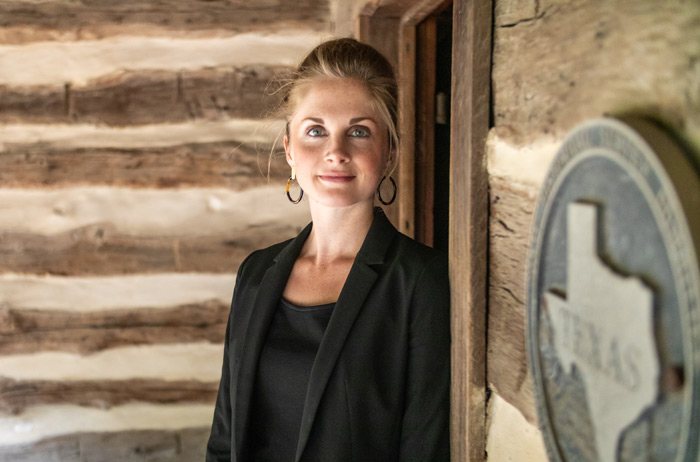According to Dr. Whitney Stewart, there’s a different way to tell the story of how people lived during the antebellum period in the U.S. By looking at the objects found at old plantations, for example, the disparity of life in the South becomes clearer.

Dr. Whitney Stewart, in front of a former slave home at Dallas Heritage Village, said such quarters reflect the racialized nature of “home” in the 19th-century South.
“I study how race as an idea, as a construct, becomes reality through the things we create, consume and discard,” said Stewart, an assistant professor of history in the School of Arts and Humanities and an affiliate of the Edith O’Donnell Institute of Art History at The University of Texas at Dallas. “Whether a quilt, a piece of furniture, landscaping or architecture, I’m interested in how we inscribe our own ideas of race into those spaces and objects.”
Stewart is writing a book that explores the racialized nature of “home” in the 19th-century South. In it, she explores plantations in Texas and Louisiana and how African Americans were motivated to create their homes during and after slavery, as well as the ramifications that have come from a racialized understanding of home.
“I want people to remember that these sites were not just sites of labor for enslaved people, but were also sites of living and sites of homebuilding, or what I call ‘home-making.’ Because when we think about home-making and how our society looks at home-making on plantations, we typically focus only on the white families,” Stewart said.
According to Stewart, because plantation tours typically focus on the large, ornate mansions, tourists who visit Southern plantations rarely get the full story of life in the South.
“I want people to remember that these sites were not just sites of labor for enslaved people, but were also sites of living and sites of homebuilding, or what I call ‘home-making.’ Because when we think about home-making and how our society looks at home-making on plantations, we typically focus only on the white families.”
Dr. Whitney Stewart, assistant professor of history in the School of Arts and Humanities
“Tourist sites throughout the South have continued this racialized landscape that evolved in the 19th century through to today. Visitors move through these spaces not realizing that enslavers, the men and women who were enslaving other people, were creating spaces that were meant to privilege whiteness over blackness,” she said.
Stewart has been working with state historians and plantation directors to encourage them to reorient the stories that are shared at Southern plantations.
“I would want to see tours start in the slave cabins and quarters because those actually are the places where the vast majority of people on these medium-to-large plantations lived. And that’s where they sought to build ‘home.’ Then we can expand out and look at the mansion, the fields, and the other areas of labor and living and begin to really understand the complex relationships and lives that were built on these plantations,” she said.
Last summer Stewart visited Southern plantations to research home life in the 19th century. This summer she received a fellowship from the National Endowment for the Humanities at the American Antiquarian Society, which will allow her to engage in archival research at the society. She will take the location-based research she has done and, by looking at published materials, broaden it beyond individual plantations to regional and national contexts.
She said her book should provide context and guidance for three different groups: academics, public historians and the general public.
“I want people to ask more questions and to ‘read the landscape’ and their material world in more nuanced ways,” Stewart said.